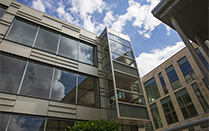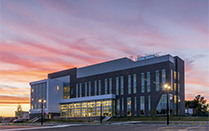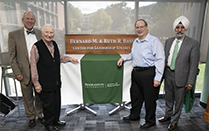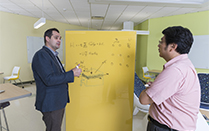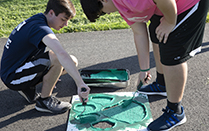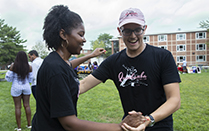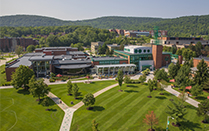Information Technology Services activities
This past quarter Information Technology Services (ITS) worked to implement new services for the campus, provide vital upgrades to our campus technical infrastructure and worked collaboratively across campus to develop applications and services to support research technology needs.
New services
Banner 9 goes “live” Sept. 19. Culminating from over eight months of work by ITS staff, the SUNY State Information and Campus Administrative System (SICAS) Center and a significant effort by key functional users across the University, ITS upgraded the Banner system to the newest version of Banner software. This upgrade necessitated significant planning, coordination and testing between all functional users, ITS and the SICAS Center. Between SICAS and Binghamton, over 200 customized forms and processes that were modified, tested and the results were verified as part of this process – all without impacting daily operations on campus. Of significant note, 42 SUNY schools utilize Banner and Binghamton will be the sixth SUNY school and the largest one thus far to complete this upgrade.
In response to a request from the Emergency Management office, ITS staff installed and customized the Alertus software to enable faster communication to students, staff and faculty in an emergency situation. Additionally, a one-time modification to MyBinghamton.edu required each user to validate/update their emergency contact information. Thus, the University is better positioned to communicate timely critical messages to students, staff, and faculty.
ITS implemented Print@Binghamton to provide students with the ability to print from personal/mobile devices and to improve the efficiency of the printing system by streamlining the print release process. In response to student feedback, ITS researched a printing solution that would best meet today’s students printing needs. The previous system in place, Pharos, was not meeting the today’s needs and demands. Investigation determined that Papercut offered the optimal solution. Papercut printing solution was purchased, installed and customized for the start of the fall semester. Although ITS experienced some initial start-of-semester printing challenges, these were overcome with students now embracing Papercut. The Pharos printing solution will be retired soon and Papercut will be the sole printing option for students.
The Innovation Team completed a complete re-write and port of the MyBinghamton.edu platform to Graphene. The new platform provides a more robust infrastructure than the original MyBinghamton.edu platform. Graphene is a cutting-edge, open-source portal platform inspired by the lessons learned from the old “myBinghamton.edu.” Graphene is future-proof, highly configurable and will allow ITS to rapidly respond to Binghamton’s evolving technology and communication needs in unprecedented and innovative ways. This upgrade was made with minimal to no user impact and negligible downtime. Additionally, the ITS Innovation Team will present its accomplishment at the annual national EDUCAUSE 2018 conference.
Upgrades to technical infrastructure
Security Cameras – Upgraded and expanded the security camera distribution across the campus. ITS staff installed almost 350 cameras in residence halls and other key areas in support of the recent presidential directive. Additionally, work was done to upgrade and replace aging cameras as needed. There are almost 1,350 cameras installed across campus, all placed in locations selected to enhance security and investigative needs.
Network upgrades across the campus – Telecommunications has supported various renovation projects across campus, including the for the new pharmacy school building at the Health Sciences Campus in Johnson City, N.Y., Academic A POD/classrooms, Science 4 (Phase 1), Seneca, Hillside Community, Newing community, Dickinson community and installation of over 60 panic buttons in RA/RD offices. Critical projects completed were network installation in the School of Pharmacy and Pharmaceutical Sciences; re-wiring and activation of the Seneca Hall network; and installation of low-voltage cable, jacks, wall plates and wireless access points for the various projects. Unfortunately, the transfer of cable services from Time Warner to Spectrum resulted in Spectrum terminating the courtesy agreement the University had with Time Warner to provide cable/internet services to University employees at a reduced rate. Telecommunications worked with all affected to transition them to native Spectrum accounts.
Work in computer PODs/classrooms – ITS worked to upgraded or replaced equipment in several computer POD/classrooms. This is an annual task as IT equipment ages and continually needs replacing. The Device Support Team and PODs staff replaced over 300 computers and 17 high-output printers prior to the start of the fall semester. This work is critical as these are the computers students use for class work and study, ensuring that students have access to the latest technology when completing their course work.
Academic A computer PODs/classrooms renovated – ITS worked with Physical Facilities to totally renovate three POD rooms in Academic A, the first major renovation in these spaces since the building was opened. ITS undertook this renovation project in anticipation of the closing of the Science 2 Computer POD rooms in September. During the course of the renovations in Academic A, the three rooms were remodeled, new network and power to the desktops were installed and new furniture including an industry-approved ADA desk were installed in each room. All three rooms are now fully functional classrooms in addition to being computer PODs.
Technology Maintenance Day Ends – After the April 2018 Technology Maintenance Day, ITS staff evaluated how maintenance of critical system was accomplished. and determined that the 24-hour, twice-a-year Technology Maintenance Day was no longer necessary. The new technology maintenance concept is built around more frequent, smaller time-segment, regularly scheduled critical-maintenance periods, typically done in the early morning hours before the majority of functional users arrive for work. A contributing factor that allowed for the more robust, less impact to functional users maintenance plan was the initial progress in developing redundant critical systems. Although redundant critical systems are in the initial phase of implementation, moving to a small, less impactful technology maintenance effort was a direct result these efforts.
ITS staff has concluded work on almost 40 summer projects and continues to work or has commenced work on the over 200 projects presently requested. Additionally, ITS has begun the planning work for several large-scale projects anticipated to commence by summer 2019, all designed to support the University’s IT needs.
